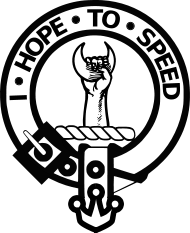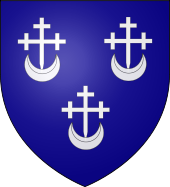- Clan Cathcart
-
Clan Cathcart Crest badge 
Crest: A dexter hand couped above the wrist and erect Proper, grasping a crescent Argent Motto: I hope to speed Profile Chief

Charles Alan Andrew Cathcart the 7th Earl Cathcart Seat Gateley Hall Historic seat Cathcart Castle Clan Cathcart is a Lowland Scottish clan.
Contents
History
Origins of the Clan
As well as being a surname Cathcart is a Scottish town just south of Glasgow. There is some speculation as to the origin of the name Cathcart. Some believe it is ancient Celtic meaning, "Fort on the River Cart", as that river flows right past the ancient castle. Others believe it means, "The straight or confined part of the Cart River". Be that as it may, the name is ancient, but originally spelled Kerkert or Kethkert, probably because of pronunciation. The Peerage refers to the Clan Cathcart. The first known mention of the Kethcarts, is a man named Rainaldus de Kethcart, who witnessed a charter by Walter Fitzalan to the Church of Kethcart for the monastery of Paisley in 1178.
Wars of Scottish Independence
Notable Cathcarts include Sir Alan Cathcart, who was a companion of King Robert I when he mounted the Scottish throne in 1307, and was engaged on his side at the Battle of Loudoun Hill that same year, when the Scots defeated the English. The following year, he was made one of Edward Bruce's party of 50 horsemen who attacked and dispersed 1,500 cavalry under John de St. John in Galloway. The Peerage quotes John Barbour's description of Sir Alan's bravery and good humor in his poem Brus.
Another notable was the first Lord Cathcart, dignified with the honour in 1447 by King James II of Scotland.
16th century and Anglo-Scottish Wars
During the Anglo-Scottish Wars Alan Cathcart the son of the second Lord Cathcart was killed with his two half brothers Robert and John when the Clan Cathcart fought against the English at the Battle of Flodden Field in 1513. The third Lord Cathcart led the clan at against the English at the Battle of Pinkie Cleugh where he was killed in 1547.
Alan Cathcart the fourth Lord Cathcart led the clan at the Battle of Langside in 1568 on the side of the James Stewart, 1st Earl of Moray against the army of Mary, Queen of Scots.
During the 16th Century Killochan Castle was built by John Cathcart in 1586.
18th century & Jacobite uprisings
The eighth Lord Cathcart, Charles Cathcart had a distinguished military career rising to the rank of colonel. When the first Jacobite Uprising broke out in 1715 he commanded troops in support of the British government at the Battle of Sheriffmuir.
When the second Jacobite Uprising broke out in 1745 the Charles Cathcart, 9th Lord Cathcart commanded troops in support of the British government at the Battle of Culloden in 1746 where he was shot in the face and wounded. He commanded the Royal Scots 1st Regiment of Foot which today is called The Royal Scots.
Napoleonic Wars
William Cathcart, the tenth Lord Cathcart accompanied his father to Russia. When he returned to Scotland he took up legal studies and was called to the Bar in 1776. When he succeeded his fathers title he gave up legal studies and returned to the army. He rose to the rank of lieutenant general and was commander in chief of the forces in Ireland. He was also created a Knight of the Thistle.
During the Napoleonic Wars in 1807 as Napoleon's troops were about to take control of Denmark, Lord Cathcart and Admiral Gambier successfully besieged Copenhagen and captured the Danish fleet of over 60 vessels together with naval stores and munitions. Lord Cathcart was rewarded with the titles Viscount Cathcart and Baron of Greenock. In June 1814 he was made Earl Cathcart.
The second Earl Cathcart also had a distinguished military career and served throughout the Peninsular War, fighting at the Battle of Waterloo in 1815. He was also the commander of the British Army in Scotland and governor of Edinburgh Castle from 1837 to 1842.
Chief
Clan Chief: The Rt. Hon. Charles Alan Andrew Cathcart of Cathcart, the 7th Earl Cathcart, Viscount Cathcart of Cathcart, Lord Cathcart and Baron Greenock of Greenock, Chief of the Name and Arms of Cathcart.[1]
Castle
- Cathcart Castle was the seat of the Earl Cathcart, chief of Clan Cathcart.
See also
External links
References
Scottish clans Clans with chiefs Agnew · Anstruther · Arbuthnott · Arthur · Bannerman · Barclay · Borthwick · Boyd · Boyle · Brodie · Broun · Bruce · Buchan · Burnett · Cameron · Campbell · Carmichael · Carnegie · Cathcart · Charteris · Chattan · Chisholm · Cochrane · Colquhoun · Colville · Cranstoun · Crichton · Cumming · Darroch · Davidson · Dewar · Drummond · Dunbar · Dundas · Durie · Elliot · Elphinstone · Erskine · Farquharson · Fergusson · Forbes · Forsyth · Fraser · Fraser of Lovat · Gayre · Gordon · Graham · Grant · Gregor · Grierson · Guthrie · Haig · Haldane · Hamilton · Hannay · Hay · Henderson · Home · Hope · Hunter · Irvine · Jardine · Johnstone · Keith · Kennedy · Kerr · Kincaid · Lamont · Leask · Lennox · Leslie · Lindsay · Lockhart · Lumsden · Lyon · MacAlister · MacBain · MacDonald · Macdonald of Clanranald · MacDonald of Keppoch · Macdonald of Sleat · MacDonell of Glengarry · MacDougall · Macdowall · MacIntyre · Mackay · Mackenzie · Mackinnon · Mackintosh · Maclachlan · Maclaine of Lochbuie · MacLaren · MacLea (Livingstone) · Maclean · MacLennan · MacLeod · MacLeod of Lewis · MacMillan · Macnab · Macnaghten · MacNeacail · MacNeil · Macpherson · MacTavish · MacThomas · Maitland · Makgill · Malcolm (MacCallum) · Mar · Marjoribanks · Matheson · Menzies · Moffat · Moncreiffe · Montgomery · Morrison · Munro · Murray · Napier · Nesbitt · Nicolson · Ogilvy · Oliphant · Primrose · Ramsay · Rattray · Riddell · Robertson · Rollo · Rose · Ross · Ruthven · Sandilands · Scott · Scrymgeour · Sempill · Shaw · Sinclair · Skene · Spens · Stirling · Strange · Stuart of Bute · Sutherland · Swinton · Trotter · Urquhart · Wallace · Wedderburn · Wemyss · Wood ·
Armigerous clans Abercromby · Abernethy · Adair · Adam · Aikenhead · Ainslie · Aiton · Allardice · Anderson · Armstrong · Arnott · Auchinleck · Baillie · Baird · Balfour · Bannatyne · Baxter · Bell · Belshes · Bethune · Beveridge · Binning · Bissett · Blackadder · Blackstock · Blair · Blane · Blyth · Boswell · Brisbane · Buchanan · Butter · Byres · Cairns · Calder · Caldwell · Callender · Campbell of Breadalbane · Campbell of Cawdor · Carruthers · Cheyne · Chalmers · Clelland · Clephane · Cockburn · Congilton · Craig · Crawford · Crosbie · Cunningham · Dalmahoy · Dalrymple · Dalzell · Dennistoun · Don · Douglas · Duncan · Dunlop · Edmonstone · Fairlie · Falconer · Fenton · Fleming · Fletcher · Forrester · Fotheringham · Fullarton · Galbraith · Galloway · Gardyne · Gartshore · Ged · Gibsone · Gladstains · Glas · Glen · Glendinning · Gray · Gunn · Haliburton · Halkerston · Halket · Hepburn · Heron · Herries · Hogg · Hopkirk · Horsburgh · Houston · Hutton · Inglis · Innes · Kelly · Kinloch · Kinnaird · Kinnear · Kinninmont · Kirkcaldy · Kirkpatrick · Laing · Lammie · Langlands · Learmonth · Little · Logan · Logie · Lundin · Lyle · MacAulay · Macbrayne · MacDuff · MacEwen · MacFarlane · Macfie · Macgillivray · MacInnes · MacIver · Mackie · MacLellan · Macquarrie · Macqueen · Macrae · Masterton · Maule · Maxton · Maxwell · McCorquodale · McCulloch · McKerrell · Meldrum · Melville · Mercer · Middleton · Moncur · Monteith · Monypenny · Mouat · Moubray · Mow · Muir · Murray of Atholl · Nairn · Nevoy · Newlands · Newton · Norvel · Ochterlony · Orrock · Paisley · Paterson · Pennycook · Pentland · Peter · Pitblado · Pitcairn · Pollock · Polwarth · Porterfield · Preston · Pringle · Purves · Rait · Ralston · Renton · Roberton · Rossie · Russell · Rutherford · Schaw · Seton · Skirving · Somerville · Spalding · Spottiswood · Stewart · Stewart of Appin · Strachan · Straiton · Strange · Sydserf · Symmers · Tailyour · Tait · Tennant · Troup · Turnbull · Tweedie · Udny · Vans · Walkinshaw · Wardlaw · Watson · Wauchope · Weir · Whitefoord · Whitelaw · Wishart · Young
Culture and society Scotland · Clan chief · Septs · Clan badge · Clan crest · Clan battles · Tartan · Bagpipes · Clearances · Kilt · Manrent · The Highlands · Battle of Culloden · Highland games · Border Reivers · Scottish heraldry · Scottish surnames
Categories:- Scottish clans
Wikimedia Foundation. 2010.

